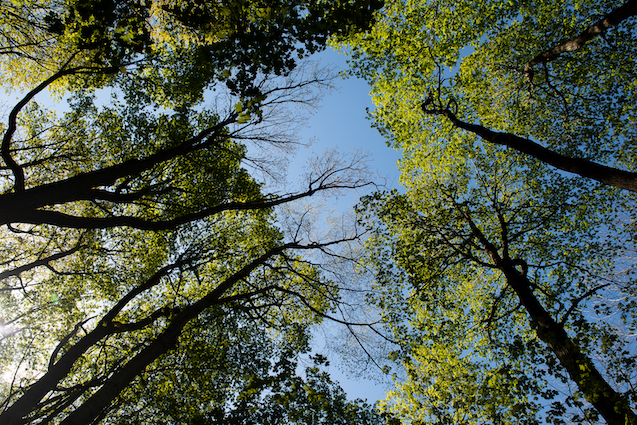In January 1998, Quebec lived through one of its greatest natural disasters. For several days, southern Quebec was pelted with freezing rain, coating trees, roads and power lines with a thick layer of ice. Montérégie was at the centre of this historic storm, which had a major impact on both infrastructure and nature.
Between 80 and 100 mm of ice covered the forests of Mont Saint-Hilaire, more than double the previous record. Only 3% of mature trees escaped undamaged. More than a third of our trees lost at least half their branches.
One of the unexpected effects of the ice storm on Gault Nature Reserve, however, was a strong research push. By coincidence, only a few months before the storm, 87 permanent research plots were installed to study the forests of Mont Saint-Hilaire. Since the storm, many scientists have worked in these plots to better understand the impacts a storm of this magnitude can have on mature forests and their natural regeneration.
The importance of long-term environmental monitoring
With these plots, the scientists were able to compare samples from before the ice storm with samples collected in the years that followed. This data is a treasure trove of information and provided a unique occasion to look into the regeneration of a forest in detail. A research team led by Dr. Martin Lechowicz, the director of the Reserve at the time, jumped at the opportunity.
During and after the storm, many trees were damaged by the weight of the ice. Twigs, branches and sometimes even trunks broke and covered the ground. Scientists estimate that about 19,900 tons of biomass were lost at the Gault Nature Reserve, representing 7% to 10% of the forest, a record level of damage for any freezing rain event.

Mountainside at the shores of Lac Hertel during the 1998 ice storm (photo: Gault Nature Reserve of McGill University)
The impact of all the broken branches
Major disruptions like the ice storm can have long-lasting impacts and can even change a forest's composition. When branches of mature trees break, they leave openings in the canopy that allow light to reach plants on the ground that larger trees would otherwise shade.
This new light can encourage the growth of young trees and even help foster the growth of species that can’t tolerate shade.

A gap in the canopy lets the light reach the ground (photo: Alex Tran).
On Mont Saint-Hilaire, the number of openings in the canopy more than doubled after the storm. Scientists made two surprising discoveries:
Despite its magnitude, the ice storm did not change the composition or diversity of the forest: Rather than encourage new species to take root, as is often the case, openings in the canopy at Mont-Saint-Hilaire helped existing young trees grow faster.
The canopy bounced back much faster than expected: In 1998, scientists theorized that the opening in the canopy could take between 20 and 25 years to return to pre-ice storm levels. However, the canopy had already regenerated by the year 2000, only three summers after the ice storm.
Damage was not the same everywhere
The plots allowed scientists to answer a previously mysterious question: did the ice storm affect the whole forest equally? It did not! In fact, researchers observed that some areas were far more damaged than others.
At the Reserve, areas rich with American beech trees (Fagus grandifolia) were particularly damaged by the storm. In contrast, the Eastern hemlock (Tsuga canadensis) was more resistant to ice storm damage, and areas where this tree is abundant were less affected.
It turns out that the severity of damage from one area to another may also have depended on the terrain. For example, trees at the bottom of a slope took more damage. Scientists believe that the accumulation of cold air in these areas could have slowed ice melting. By affecting the direction and strength of winds, the terrain can also impact the damage's severity.

(Photo: Gault Nature Reserve of McGill University).
Better predicting future storms
The 1998 ice storm was a historic event that brought southern Quebec to a screeching halt for several weeks. While it brought about difficult conditions, it was also an opportunity to improve our knowledge of these storms. As we learned, a disaster of this magnitude requires a large-scale, coordinated response. The new AEOS1 lab opened last summer at Gault Nature Reserve could help scientists better understand and predict these kinds of winter storms.
Frédérique Truchon
Communications associate
Gault Nature Reserve of McGill University
1. The acronym AEOS stands for Adaptable Earth Observation System
References
1. Stéphanie M Duguay, Ken Arii, Michael Hooper, and Martin J Lechowicz. 2001. Ice Storm Damage and Early Recovery in an Old-Growth Forest. Environmental Monitoring and Assessme:t 67, 97–108. https://doi.org/10.1023/A:1006464511158
2. Michael C Hooper, Ken Arii, and Martin J Lechowicz. 2001. Impact of a major ice storm on an old-growth hardwood forest. Canadian Journal of Botany. 79(1): 70-75. https://doi.org/10.1139/b00-148
3. Koichi Takahashi, Ken Arii, and Martin J.Lechowicz. 2007. Quantitative and qualitative effects of a severe ice storm on an old-growth beech–maple forest. Canadian Journal of Forest Research. 37(3): 598-606. https://doi.org/10.1139/X06-266



